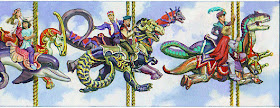Here is a classic love story, painted by E. Blair Leighton, called "The End of the Song."
A handsome harpist woos a fair young princess on the balcony of a palace. She has set aside her embroidery and listens shyly to his songs and overtures. A coil of honeysuckle, symbolizing love, happiness, and new opportunities, ascends the column at left.
Unseen to them, a crowned figure returns from a walk in the forest. Evidently her father, he strokes his beard as he considers what to do about this turn of events.
But that's not how E. Blair Leighton originally painted the picture in 1902.

An earlier version shows the girl's father with a more stern countenance. His hand is ready to unsheathe his sword. Will he slay the young man, or at least to chase him off by threat of violence?
When E. Blair Leighton was still a student, a piece of advice he took to heart was, “In art it is never too late to alter your work if it is wrong.” The change of the king's face and hand makes a huge difference. But is it an improvement? Which version do you prefer? (Assuming both were in full color)
-------
ADDENDUM Sept. 10: The poll closed with 190 votes in favor of the artist's first conception (hand on sword) versus 200 votes in favor of the revised version, seen in color with the man stroking his beard.
Several blog readers noted that the scene is unmistakably from
Tristan and Iseult. As Matthew Mattin pointed out, the Wikipedia article "mentions several elements of the legend that appear in the painting, most notably an episode in which King Mark attacks Tristan while he is playing the harp for Iseult. But it is also part of the story that King Mark and Tristan, his nephew, love and revere each other, and that the love between T and I was induced by a love potion, resolving them responsibility to some extent and complicating Mark's options in response. So both the violent episode and the ambiguous context are true to the story. "
-----
Biography on ArtMagick
Thanks, Barry Klugerman












































